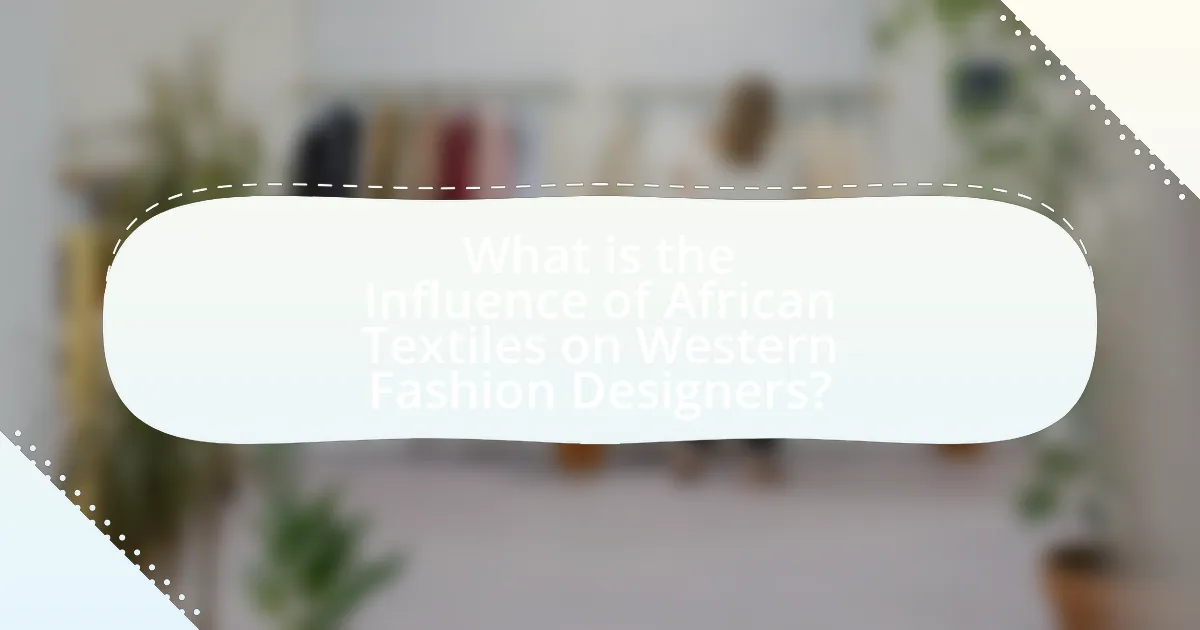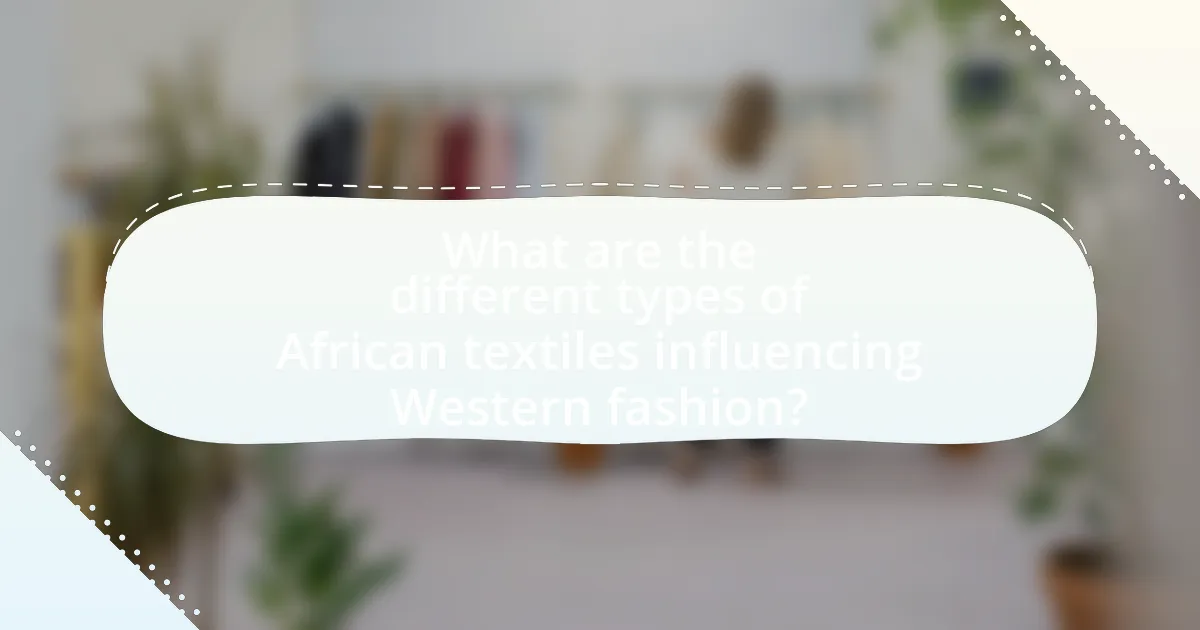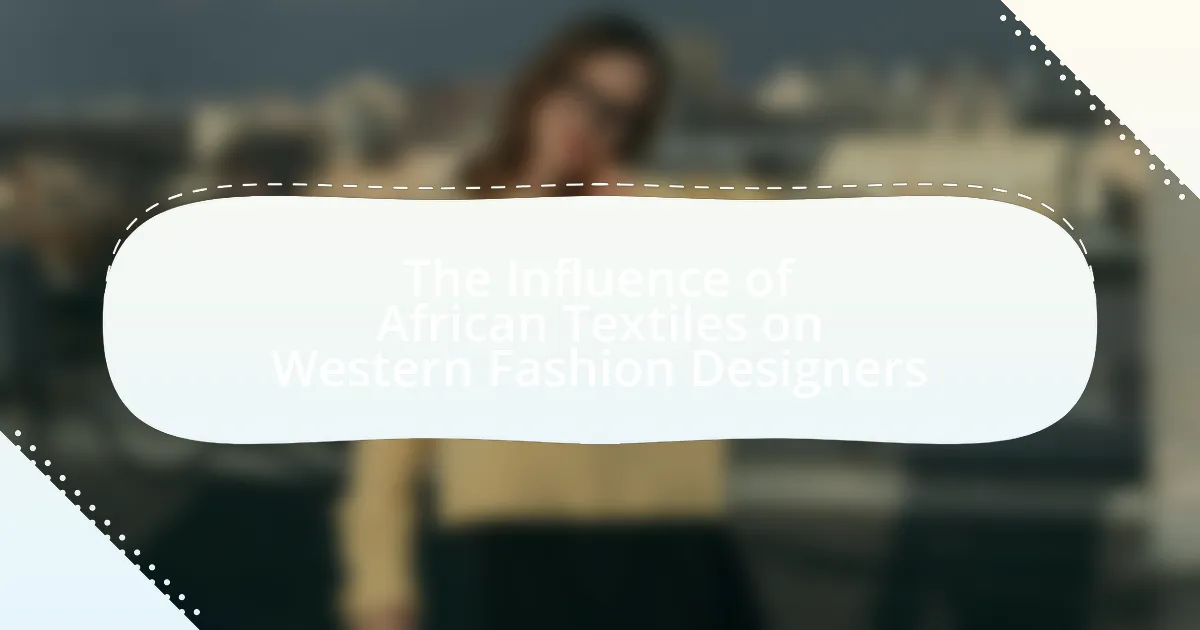The article examines the significant influence of African textiles on Western fashion designers, highlighting how vibrant colors, intricate patterns, and unique techniques have shaped contemporary fashion. It discusses the historical impact of African textiles, such as Kente cloth and mud cloth, and their role in promoting cultural diversity and appreciation within the fashion industry. The article also addresses challenges related to cultural appropriation, ethical considerations, and best practices for collaboration between Western designers and African artisans, emphasizing the importance of authenticity and respect for cultural heritage.

What is the Influence of African Textiles on Western Fashion Designers?
African textiles significantly influence Western fashion designers by introducing vibrant colors, intricate patterns, and unique textile techniques. Designers such as Stella McCartney and Yves Saint Laurent have incorporated African prints and motifs into their collections, showcasing the cultural richness and craftsmanship of African textiles. For instance, the use of Kente cloth in high-fashion garments highlights the textile’s historical significance and aesthetic appeal. This cross-cultural exchange not only enriches Western fashion but also promotes awareness and appreciation of African heritage, as seen in the increasing popularity of African-inspired fashion shows and collaborations.
How have African textiles historically impacted Western fashion?
African textiles have historically impacted Western fashion by introducing vibrant colors, intricate patterns, and unique techniques that have influenced designers and trends. The use of textiles such as kente cloth and mud cloth has inspired Western designers to incorporate these elements into their collections, leading to a fusion of styles. For instance, in the 1980s, designers like Yves Saint Laurent and Jean-Paul Gaultier drew from African motifs, showcasing them on runways and in high fashion. This incorporation not only broadened the aesthetic appeal of Western fashion but also sparked a greater appreciation for cultural diversity in design. The influence of African textiles continues to be evident in contemporary fashion, as designers increasingly seek to celebrate and honor these rich traditions.
What are the key characteristics of African textiles that attract Western designers?
The key characteristics of African textiles that attract Western designers include vibrant colors, intricate patterns, and cultural significance. Vibrant colors are often derived from natural dyes and reflect the rich landscapes and traditions of various African cultures. Intricate patterns, such as those found in Kente cloth from Ghana or mud cloth from Mali, convey stories and social status, making them appealing for their depth and narrative quality. Additionally, the cultural significance of these textiles, often tied to rituals and identity, resonates with Western designers seeking authenticity and uniqueness in their collections. This combination of aesthetic appeal and cultural richness makes African textiles a source of inspiration for contemporary fashion.
How did colonialism shape the perception of African textiles in the West?
Colonialism significantly shaped the perception of African textiles in the West by framing them as exotic and primitive, which influenced Western fashion designers’ interpretations. During the colonial period, European powers often portrayed African cultures as inferior, leading to a fascination with their textiles that was rooted in stereotypes rather than genuine appreciation. This resulted in a commodification of African textiles, where they were viewed primarily as decorative items rather than as expressions of cultural identity. For instance, the introduction of African prints in Western fashion during the 19th and 20th centuries often stripped these textiles of their cultural significance, reducing them to mere trends. This perception was further reinforced by exhibitions and collections that emphasized their ‘otherness,’ thereby shaping a narrative that prioritized Western aesthetics over authentic African artistry.
Why are African textiles significant in contemporary fashion?
African textiles are significant in contemporary fashion due to their rich cultural heritage, unique patterns, and vibrant colors that inspire designers globally. These textiles, such as kente cloth and mud cloth, reflect the diverse traditions and histories of various African communities, making them a source of authenticity and storytelling in fashion. The incorporation of African textiles into contemporary designs not only promotes cultural appreciation but also supports sustainable practices by highlighting artisanal craftsmanship. Furthermore, the global fashion industry increasingly recognizes the importance of diversity and inclusivity, leading to a growing demand for African-inspired designs that resonate with a wider audience.
What role do African textiles play in promoting cultural diversity in fashion?
African textiles play a crucial role in promoting cultural diversity in fashion by introducing unique patterns, colors, and techniques that reflect the rich heritage of various African cultures. These textiles, such as kente cloth from Ghana and mud cloth from Mali, not only serve as a medium of artistic expression but also tell stories of identity, tradition, and community. The incorporation of African textiles into global fashion trends has led to a broader appreciation for cultural narratives, fostering inclusivity and dialogue among diverse fashion communities. This influence is evident in the works of prominent designers like Stella Jean and Duro Olowu, who blend African motifs with contemporary styles, thereby enhancing the cultural tapestry of the fashion industry.
How do Western designers incorporate African textiles into their collections?
Western designers incorporate African textiles into their collections by utilizing traditional patterns, fabrics, and techniques that reflect the cultural heritage of Africa. Designers such as Stella McCartney and Vivienne Westwood have featured vibrant prints and handwoven materials, often collaborating with African artisans to ensure authenticity and respect for the craft. For instance, the use of Kente cloth, a traditional Ghanaian textile, has been prominent in various collections, showcasing its intricate designs and colors. This incorporation not only enhances the aesthetic appeal of the garments but also promotes cultural appreciation and awareness within the fashion industry.

What are the different types of African textiles influencing Western fashion?
African textiles influencing Western fashion include Kente cloth, Ankara fabric, Mudcloth, and Adire. Kente cloth, originating from Ghana, is known for its vibrant colors and intricate patterns, symbolizing cultural heritage and identity. Ankara fabric, widely used in West Africa, features bold prints and has gained popularity in contemporary fashion for its versatility and aesthetic appeal. Mudcloth, or Bogolanfini, from Mali, is characterized by its hand-dyed patterns and earthy tones, often used in high-end fashion collections. Adire, a traditional Yoruba textile, employs indigo dyeing techniques and has inspired various designers in their collections. These textiles not only showcase African artistry but also contribute to the global fashion narrative, reflecting a blend of cultural influences.
What are the most popular African textile techniques used by Western designers?
The most popular African textile techniques used by Western designers include batik, kente weaving, and mud cloth. Batik, originating from Indonesia but widely adopted in West Africa, involves a wax-resist dyeing method that creates intricate patterns, which has been embraced by designers for its vibrant colors and unique designs. Kente weaving, a traditional Ghanaian technique, utilizes brightly colored silk and cotton to create elaborate patterns that symbolize cultural significance, making it a favored choice for high-fashion collections. Mud cloth, or bogolanfini, from Mali, is made using fermented mud to dye cotton fabric, resulting in distinctive earthy tones and patterns that resonate with contemporary aesthetics. These techniques not only showcase the rich cultural heritage of Africa but also influence global fashion trends, as evidenced by their incorporation into collections by renowned designers such as Stella McCartney and Yves Saint Laurent.
How does the use of batik influence modern fashion trends?
The use of batik significantly influences modern fashion trends by introducing unique patterns and cultural narratives into contemporary designs. Batik’s intricate motifs and vibrant colors have inspired designers to incorporate these elements into their collections, resulting in a fusion of traditional craftsmanship with modern aesthetics. For instance, designers like Stella Jean and Issey Miyake have utilized batik techniques to create garments that celebrate cultural heritage while appealing to global fashion markets. This integration not only enhances the visual appeal of clothing but also promotes cultural appreciation and sustainability in fashion, as batik is often made using eco-friendly methods.
What is the significance of kente cloth in Western fashion design?
Kente cloth holds significant importance in Western fashion design as a symbol of cultural heritage and artistic expression. Its vibrant colors and intricate patterns have inspired numerous designers, leading to the incorporation of kente motifs into contemporary fashion collections. For instance, designers like Stella McCartney and Gucci have featured kente-inspired designs, showcasing the cloth’s aesthetic appeal and cultural richness. This integration not only highlights the versatility of kente cloth but also promotes a greater appreciation for African textiles within the global fashion industry.
How do patterns and colors in African textiles affect Western fashion aesthetics?
Patterns and colors in African textiles significantly influence Western fashion aesthetics by introducing vibrant hues and intricate designs that challenge conventional Western norms. The bold geometric patterns and rich color palettes found in African textiles inspire Western designers to incorporate more diverse and expressive elements into their collections. For instance, designers like Stella Jean and Balenciaga have drawn from African motifs, leading to a broader acceptance of cultural diversity in fashion. This cross-cultural exchange not only enhances creativity but also promotes inclusivity, as seen in the increasing popularity of African-inspired prints on runways and in retail.
What emotions or messages do specific patterns convey in African textiles?
Specific patterns in African textiles convey a range of emotions and messages, often reflecting cultural identity, social status, and historical narratives. For instance, the Adinkra symbols from the Akan people of Ghana communicate concepts such as wisdom, strength, and unity, with each symbol carrying a specific meaning that resonates with the community’s values. Additionally, the use of vibrant colors and intricate designs in Kente cloth signifies celebration and is often worn during important ceremonies, conveying joy and cultural pride. The patterns serve not only as aesthetic elements but also as a means of storytelling, preserving the heritage and beliefs of the people.
How do color choices in African textiles inspire Western fashion palettes?
Color choices in African textiles significantly inspire Western fashion palettes by introducing vibrant hues and bold patterns that reflect cultural heritage. Designers in the West often draw from the rich color schemes found in African fabrics, such as the use of deep reds, bright yellows, and earthy tones, which evoke a sense of tradition and authenticity. For instance, the incorporation of kente cloth patterns, known for their striking colors and geometric designs, has influenced collections by major fashion houses like Gucci and Stella McCartney. This cross-cultural exchange not only diversifies Western fashion but also elevates the appreciation of African artistry, as seen in the increasing presence of African-inspired collections on global runways.

What challenges do Western designers face when using African textiles?
Western designers face several challenges when using African textiles, primarily related to cultural appropriation, authenticity, and sourcing. Cultural appropriation arises when designers use African textiles without understanding their cultural significance, leading to potential backlash from communities. Authenticity is another challenge, as designers must navigate the complexities of representing traditional patterns and techniques accurately, which can be difficult without proper knowledge or collaboration with local artisans. Additionally, sourcing these textiles can be problematic due to issues like fair trade practices and supply chain transparency, which are essential for ethical fashion. These challenges highlight the need for sensitivity and respect in the integration of African textiles into Western fashion.
How can cultural appropriation be addressed in the use of African textiles?
Cultural appropriation in the use of African textiles can be addressed through respectful collaboration with African artisans and communities. By engaging in partnerships that prioritize fair compensation and cultural exchange, Western designers can ensure that the origins and significance of the textiles are honored. For instance, initiatives like the African Fashion International promote local designers and emphasize the importance of cultural context, which helps mitigate appropriation. Additionally, educating consumers about the cultural heritage of these textiles fosters appreciation rather than exploitation, as seen in campaigns by organizations like the Ethical Fashion Initiative.
What are the ethical considerations for Western designers working with African textiles?
Western designers must consider cultural appropriation, fair compensation, and sustainability when working with African textiles. Cultural appropriation involves using traditional designs without understanding their significance, which can lead to misrepresentation and disrespect towards the originating cultures. Fair compensation is crucial, as many African artisans and communities rely on textile production for their livelihoods; designers should ensure that they are paid fairly for their work and that profits are shared equitably. Sustainability is also a key consideration, as the fashion industry has significant environmental impacts; designers should prioritize eco-friendly practices and materials to minimize harm to the environment. These ethical considerations are essential for fostering respectful and equitable relationships between Western designers and African textile communities.
How can designers ensure respectful representation of African cultures?
Designers can ensure respectful representation of African cultures by engaging in thorough research and collaboration with African artists and communities. This approach allows designers to gain authentic insights into cultural significance, symbolism, and traditional practices associated with African textiles. For instance, the use of specific patterns and colors often carries deep meanings that can be misrepresented if not understood properly. Collaborating with local artisans not only fosters respect but also supports the preservation of cultural heritage, as seen in initiatives like the African Fashion International, which promotes local designers and their narratives. By prioritizing these practices, designers can create work that honors and accurately reflects the richness of African cultures.
What are the best practices for collaborating with African textile artisans?
The best practices for collaborating with African textile artisans include establishing respectful partnerships, ensuring fair compensation, and promoting cultural exchange. Respectful partnerships involve understanding and valuing the artisans’ cultural heritage and craftsmanship, which fosters trust and collaboration. Fair compensation is crucial, as it acknowledges the artisans’ skills and labor, often leading to sustainable livelihoods; for instance, the Ethical Fashion Initiative emphasizes fair wages as a standard practice. Promoting cultural exchange allows for the sharing of ideas and techniques, enriching both the artisans’ and designers’ creative processes. These practices not only enhance the quality of collaboration but also contribute to the preservation and appreciation of African textile traditions within the global fashion industry.
How can Western designers build sustainable partnerships with African textile producers?
Western designers can build sustainable partnerships with African textile producers by prioritizing fair trade practices and fostering long-term relationships. Establishing fair pricing models ensures that producers receive equitable compensation, which supports their communities and encourages sustainable production methods. Additionally, designers should engage in collaborative design processes that respect and incorporate local cultural aesthetics, thereby enhancing the authenticity of the products. Research indicates that partnerships based on mutual respect and shared goals lead to more sustainable outcomes, as seen in initiatives like the Ethical Fashion Initiative, which connects designers with artisans in Africa to promote sustainable practices and economic empowerment.
What steps can be taken to promote fair trade in the textile industry?
To promote fair trade in the textile industry, stakeholders can implement several key steps. First, establishing transparent supply chains ensures that all participants, from farmers to manufacturers, receive fair compensation for their work. For instance, organizations like Fair Trade International provide certification that guarantees fair wages and safe working conditions, which can be adopted by textile companies. Second, educating consumers about the benefits of fair trade products encourages informed purchasing decisions, leading to increased demand for ethically produced textiles. Research indicates that consumers are willing to pay more for fair trade items, which can drive industry change. Third, collaborating with local artisans and communities fosters sustainable practices and preserves cultural heritage, as seen in initiatives that connect African textile producers with Western designers. These steps collectively enhance the viability of fair trade in the textile sector, promoting ethical practices and economic equity.
What practical tips can Western designers follow when incorporating African textiles?
Western designers should prioritize cultural sensitivity and authenticity when incorporating African textiles. This involves researching the origins and meanings of specific textiles, as many patterns and colors hold significant cultural symbolism. For instance, the Kente cloth from Ghana is not just a fabric but represents historical narratives and social status. Designers should also collaborate with African artisans to ensure that the craftsmanship and traditional techniques are respected and accurately represented. Engaging in fair trade practices is essential, as it supports local economies and promotes ethical sourcing. By understanding the cultural context and collaborating with local communities, Western designers can create collections that honor the rich heritage of African textiles while appealing to a global audience.
How can designers effectively research and understand the cultural significance of textiles?
Designers can effectively research and understand the cultural significance of textiles by engaging in comprehensive field studies, collaborating with local artisans, and analyzing historical contexts. Field studies allow designers to observe traditional textile practices and their meanings within specific cultures, providing firsthand insights into the materials and techniques used. Collaborating with local artisans fosters a deeper understanding of the cultural narratives and symbolism embedded in textiles, as artisans often possess extensive knowledge passed down through generations. Additionally, analyzing historical contexts, such as the role of textiles in social, economic, and political spheres, helps designers grasp the evolution of textile significance over time. For instance, the use of kente cloth in Ghana is not only a fashion statement but also a representation of cultural identity and heritage, reflecting the values and history of the Akan people.
What resources are available for Western designers to learn about African textile traditions?
Western designers can access various resources to learn about African textile traditions, including books, online courses, and cultural institutions. Notable books such as “African Textiles: Color and Creativity Across a Continent” by John Gillow provide in-depth insights into the history and techniques of African textiles. Online platforms like Coursera and Skillshare offer courses focused on textile design that incorporate African influences. Additionally, museums such as the African Museum in Belgium and the Museum of African Art in New York host exhibitions and provide educational materials that explore African textile heritage. These resources collectively enhance understanding and appreciation of African textile traditions among Western designers.

Leave a Reply